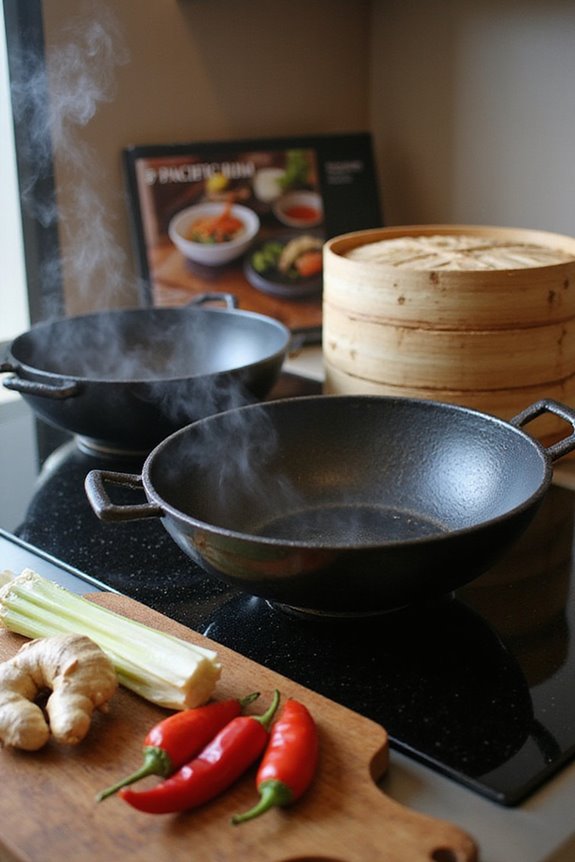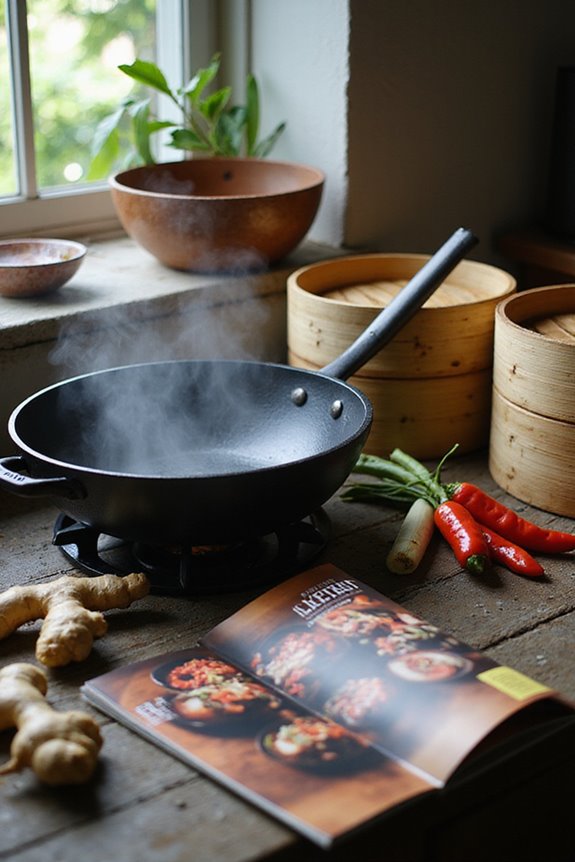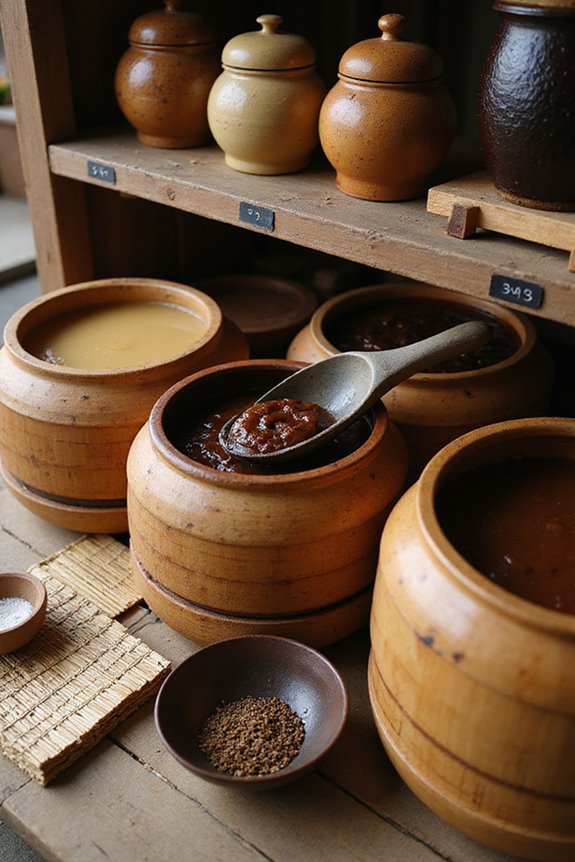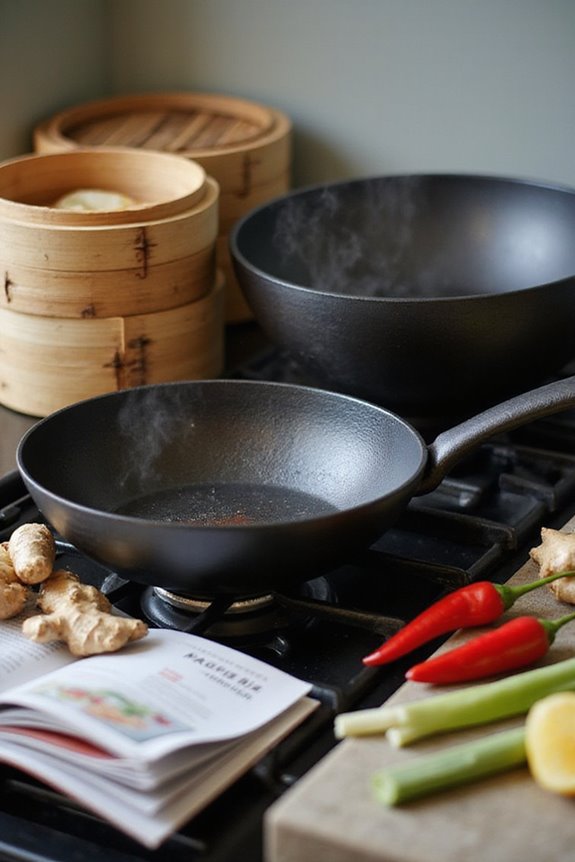Miso comes in various types, each bringing its unique magic to our dishes! Here’s a quick look:
- Rice Miso: Smooth and sweet; great for dressings.
- Barley Miso: Nutty flavor; perfect for sauces.
- Soybean Miso: Bold umami; ideal for hearty stews.
The color ranges from light to dark, with darker misos offering richer flavors. Remember, experimenting with miso is like unwrapping delightful holiday gifts—each one surprises us! Stick around to discover some tasty culinary tips!
Key Takeaways
- Miso types vary primarily by ingredient: rice, barley, soybean, or blends, each offering unique flavors and textures.
- Color indicates flavor intensity; lighter misos, like white, are mild, while darker misos, like red, provide robust umami.
- Regional variations reflect cultural significance; for example, Tohoku features robust miso, while Kansai is known for mellow rice miso.
- Fermentation time impacts flavor complexity; soybean miso can age one to four years for deeper richness.
- Nutritional content varies but generally includes high protein, antioxidants, and probiotics, beneficial for health-conscious consumers.
Types of Miso by Primary Ingredient
When we plunge into the delightful world of miso, we discover magical flavors waiting to transform our dishes! Let’s explore types of miso by primary ingredient and the unique characteristics they bring to the table.
- Rice Miso (Kome Miso): The most popular, with a smooth texture, made from soybeans, rice koji, and salt.
- Barley Miso (Mugi Miso): Offers a sweet, nutty flavor, thanks to its barley koji.
- Soybean Miso (Mame Miso): Purely soy, featuring a bold umami punch—perfect for a hearty stew!
- Blended Miso (Chōgō Miso): Combines various miso types for a flavor-packed twist.
Low sodium options can be found within each type, providing health-conscious consumers with better heart health without compromising on taste. With these varieties, we’re sure to find a delightful miso for every culinary adventure! Let’s get cooking!
Color and Flavor Profiles

Diving into the exquisite world of miso color and flavor profiles opens up a whole new domain of culinary possibilities! Each type of miso brings its unique charm to the table, with delightful variations in color intensity and flavor complexity.
- White Miso: Light yellow to beige, mild, sweet, and creamy—perfect for dressings!
- Yellow Miso: Pale yellow to light brown, slightly salty with balanced acidity—great for sauces!
- Red Miso: Deep reddish-brown, packing a robust umami punch; ideal for hearty stews!
As a rule of thumb, the darker the miso, the richer the flavor. Furthermore, it’s important to note that high-quality miso contains fewer additives, focusing on natural components to enhance your culinary experience. So, whether you’re crafting a magical holiday soup or a savory glaze, let color guide your miso choice! Happy cooking!
Geographic and Cultural Varieties

Exploring the wonderful variety of miso based on geography and culture offers us a tasty journey through Japan’s culinary landscape! Each region showcases unique flavors tied to regional traditions and ingredients. For instance:
- Tohoku provides a robust reddish miso, perfect for winter warmth.
- Meanwhile, Kansai tempts with its mellow white rice miso, a lovely choice for dishes like Saikyo-zuke.
Let’s not forget Hokuriku, blending the best of both worlds, or Kyushu and Shikoku, celebrated for their barley miso! These delightful varieties not only enhance our meals but also reflect the cultural significance of miso in Japan. Additionally, many types of miso are praised for their nutritional benefits, providing probiotics that support gut health. So, whether it’s for a holiday gathering or a cozy dinner, let’s embrace the magical world of miso!
Fermentation Process and Aging

The process of fermentation is truly magical, as it transforms simple ingredients into the delightful flavors of miso we all love. Different types of miso undergo varying fermentation durations. For instance:
- Rice and barley miso usually ferment for just a few months to a year.
- Soybean miso, like Hatcho, can age for one to four years!
Longer fermentation brings wonderful aging effects, deepening flavors and darkening colors. Think of it as a fine wine getting better with age!
This extended process allows proteins to break down into tasty umami peptides, enhancing nutritional value. Additionally, miso shares similarities with lemongrass powders as both ingredients can elevate your culinary creations. So, when you’re picking your miso, remember that the longer it ferments, the more complex and exciting the flavors become—perfect for your next cooking adventure!
Texture and Usage

After discovering how fermentation breathes life into miso, let’s reveal another layer of its charm—texture! The delightful texture variations of miso can truly elevate our dishes. Here’s how to enjoy them:
- Extra Smooth Miso: Perfect for creamy sauces and dressings.
- Smooth Miso: A go-to for miso soup or glazes—no grainy bits here!
- Small Grains Miso: Adds bursts of flavor in hearty stews—it’s all about the experience!
- Grainy Brown Rice Miso: Its coarse texture shines in soups and marinades, bringing a nutty depth. Miso’s unique textures are often celebrated in Asian culinary collections, enhancing both authenticity and flavor in traditional dishes.
Nutritional Characteristics
When we explore the nutritional characteristics of miso, we discover a delightful mix of benefits that can make our meals both healthy and tasty. It’s like finding a treasure chest of nutrients! Here’s a quick peek:
- Protein: About 17g per 100g, perfect for plant-based diets.
- Vitamins & Minerals: Rich in manganese and vitamin K, which support our bones and blood health.
- Fermentation Benefits: Packed with antioxidants and probiotics, helping our gut health flourish!
- Sodium Consideration: High sodium levels make it essential for those with dietary restrictions to pick wisely.
Miso truly enhances our dishes while offering magical health benefits. Additionally, using miso in pressure cooked soups can maximize its flavor and nutritional potential. So, whether we’re whipping up a cozy soup or seasoning a stir-fry, let’s embrace miso’s goodness and enjoy cooking together!
Culinary Applications
Releasing the culinary magic of miso opens up a world of flavor that can transform even the simplest dishes into delightful creations! Let’s explore how we can use different miso types in our cooking adventures:
- Shiro Miso: Perfect for light soups and invigorating salad dressings.
- Aka Miso: Ideal for hearty soups and rich stews that warm the soul.
- Awase Miso: A fantastic all-purpose choice, combining the best of both worlds for everyday meals.
- Mugi Miso: A great option for sauces, imparting a subtle nutty flavor.
- Genmai Miso: Perfect for vegetarian dishes, enhancing soups with earthy depth.
How to Choose the Right Miso
Choosing the right miso can feel like starting on a delightful flavor journey! First, consider the dish you’ll create. For lighter meals, we might reach for mild white miso; its subtle sweetness is like a gentle hug for our taste buds. Looking for something robust? Red miso’s deep umami adds a magical kick to hearty stews.
Let’s not forget miso pairings! Barley miso brings earthy complexity, enhancing veggies without overpowering them. To strike the perfect balance, check miso color—lighter means milder flavors, while darker misos are stronger.
Frequently Asked Questions
Can Miso Be Used in Non-Japanese Recipes?
Absolutely, we can use miso in non-Japanese recipes! Its diverse miso flavors enhance dishes with culinary fusion, adding umami to soups, dressings, and even baked goods. Together, we can explore creativity in our cooking!
What Are Common Substitutes for Miso?
Imagine savoring a warm bowl of soup. For that comforting flavor, we can explore miso alternatives like soy sauce or tahini, each bringing unique flavor profiles that connect us in delightful culinary adventures.
How Should Miso Be Stored?
When it comes to miso storage methods, we should always keep it sealed in the fridge. This not only boosts its shelf life but also guarantees we enjoy its fresh, rich flavor for longer.
Is Miso Gluten-Free?
We comprehend miso can be tricky for those with miso allergies. If we’re eyeing miso nutrition, pure soybean miso is our safest bet, while checking labels guarantees we steer clear of gluten-containing types.
Can Miso Be Eaten Raw?
Absolutely, we can enjoy raw miso! Its benefits include a rich nutritional value, packed with probiotics that support gut health. Incorporating raw miso into our meals connects us with its savory goodness and enhances our overall wellness.




